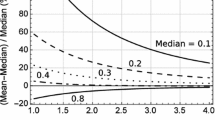Summary
Usually, rock joints are observed in outcrops and excavation walls only as traces. Under some assumptions about the shapes of the joints and the nature of their size distributions, the underlying joint size distribution can be estimated from trace length measurements. However, the interpretation of trace length distributions from line mapping data should be approached with caution. The data are always length-biased and furthermore, the semi-trace length, the trace length, and the underlying joint size may have different distributional forms. Semi-trace length distributions are monotonic decreasing functions not sensitive to changes in the real trace length distributions. Experimental full trace length distributions are shown to have lognormal distributions and to be insensitive to major changes in the underlying joint size distributions. Under the assumptions of joint convexity and circularity a parametric model for the three-dimensional distribution of joint sizes is developed. A maximum likelihood estimation of the distribution of joint diameters, which best reflects the observed joint trace data, and corrects simultaneously for joint censoring, truncation and size bias, is developed. The theory is illustrated with numerical examples using data collected from five field sites.
Similar content being viewed by others
References
Baecher, G. B. (1980): Progressively censored sampling of rock joints traces. Mathematical Geology 12 (1), 33–40.
Baecher, G. B., Lanney, N. A. (1978): Trace length biases in joint surveys. In: Proc. 19th U. S. Symp. Rock Mech., Mackay School of Mines, 56–65.
Baecher, G. B., Einstein, H. H., Lanney, N. A. (1977): Statistical description of rock properties and sampling. In: Proc. 18th U. S. Symp. Rock Mech., Colorado School of Mines, 5C 1–8.
Baldwin, J. T., Swain, H. D., Clark, G. H. (1978): Geology and grade distribution of the Panguna porphyry copper deposit, Bougainville, Papua New Guinea. Econ. Geol. 73 (5), 690–702.
Billaux, D., Chiles, J. P., Hestir, K., Long, J. (1989): Three dimensional statistical modelling of a fractured rock mass — An example from the Fanay-Augeres mine. Int. J. Rock Mech. Min. Sci. Geomech. Abstr. 26, 281–299.
Call, R. D., Savely, J. P., Nicholas, D. E. (1976): Estimation of joint set characteristics from surface mapping data. In: Hustrulid, W. A. (ed.), Monograph on rock mech. appl. in mining, AIME, New York, 65–73.
Chan, L. P. (1986): Application of block theory and simulation techniques to optimum design of rock excavations. PhD Thesis, University of California, Berkeley.
Cox, D. R. (1959): Some sampling problems in technology. In: Johnson, N., Smith, H. (eds.), New developments in survey sampling. Wiley, New York, 507–513.
Crofton, M. W. (1885): Probability. In: Encyclopedia Britannica. 9th edn. 19, 768.
Crow, I. L., Shimizu, K. (eds.) (1988): Statistics: Textbooks and monographs. Vol. 88, Marcel Dekker, New York.
Cruden, D. M. (1977): Describing the size of discontinuities. Int. J. Rock Mech. Min. Sci. Geomech. Abstr. 14, 133–137.
De Roo, J. A. (1989): The Elura Ag−Pb−Zn Mine in Australia — Ore genesis in a slate belt by synodeformational metasomatism along hydrothermal fault conduits. Econ. Geol. 84, 256–278.
Epstein, B. (1954): Truncated life tests in the exponential case. Ann. Math. Statist. 25, 555.
Epstein, B. (1960): Estimation from life test data. Technometrics 3, 107–109.
Fullman, R. L. (1953): Measurements of particle sizes in opaque bodies. F. Metals 5, 447–452.
Kendall, M. G., Moran, P. A. P. (1963): Geometrical probability. Griffin's Statistical Monographs and Courses 10, 86–89.
Kendall, M. G., Stuart, A. (1973): The advanced theory of statistics. Hafner, New York.
Kubackova, L., Kubacek, L., Kukuba, J. (1987): Probability and statistics in geodesy and geophysics. Elsevier, Amsterdam.
Kvapil, R., Baeza, L., Rosenthal, J., Flores, G. (1989): Block caving at El Teniente Mine, Chile. Trans. Inst. Min. Metall. 98, A 43–56.
Laslett, G. M. (1982): Censoring and edge effects in areal and line transect sampling of rock joint traces. Mathematical Geology 14 (2), 125–139.
O'Sullivan, F. (1986): A statistical perspective on ill-posed inverse problems. Statistical Science 1(4), 502–527.
Press, W. H., Flannery, B. P., Teukolsky, S. A., Vetterling, W. T. (1985). Numerical recipes: The art of scientific computing. Cambridge University Press, Cambridge.
Priest, S. D. (1985): Hemispherical projection methods in rock mechanics. Allen and Unwin, London.
Priest, S. D., Hudson, J. A. (1981): Estimating discontinuity spacing and trace length using scanline surveys. Int. J. Rock Mech. Min. Sci. Geomech. Abstr. 18, 183–197.
Richards, H. C., Bryan, W. H. (1933). The problem of the Brisbane tuff. In: Proc., Roy. Soc. Qld. 45, 50–62.
Roleau, A. (1984): Statistical characterization and numerical simulation of a fracture system — Application to groundwater flow in the stripa granite. PhD Thesis, University of Waterloo, Ontario.
Santalo, L. A. (1955): Sorbe la distribucion de los tamanos de corpusculos contenidos en un cuerpo a partir de la distribucion en sus secciones a proyecciones. Trabajos de estadistica 6, 181–196.
Terzaghi, R. D. (1965): Sources of error in joint surveys. Géotechnique 15, 287–303.
Wade, M. L., Solomon, M. (1958): Geology of the Mt. Lyell Mine, Tasmania. Econ Geol. 53, 367–416.
Warburton, P. M. (1980): A stereological interpretation of joint trace data. Int. J. Rock Mech. Min. Sci. Geomech. Abstr. 17, 181–190.
Weibel, E. R. (1980): Stereological methods. Academic Press, London.
Wicksell, S. D. (1925): The corpuscle problem I; A mathematical study of a biometric problem. Biometrika 17, 84–99.
Author information
Authors and Affiliations
Rights and permissions
About this article
Cite this article
Villaescusa, E., Brown, E.T. Maximum likelihood estimation of joint size from trace length measurements. Rock Mech Rock Engng 25, 67–87 (1992). https://doi.org/10.1007/BF01040513
Issue Date:
DOI: https://doi.org/10.1007/BF01040513




